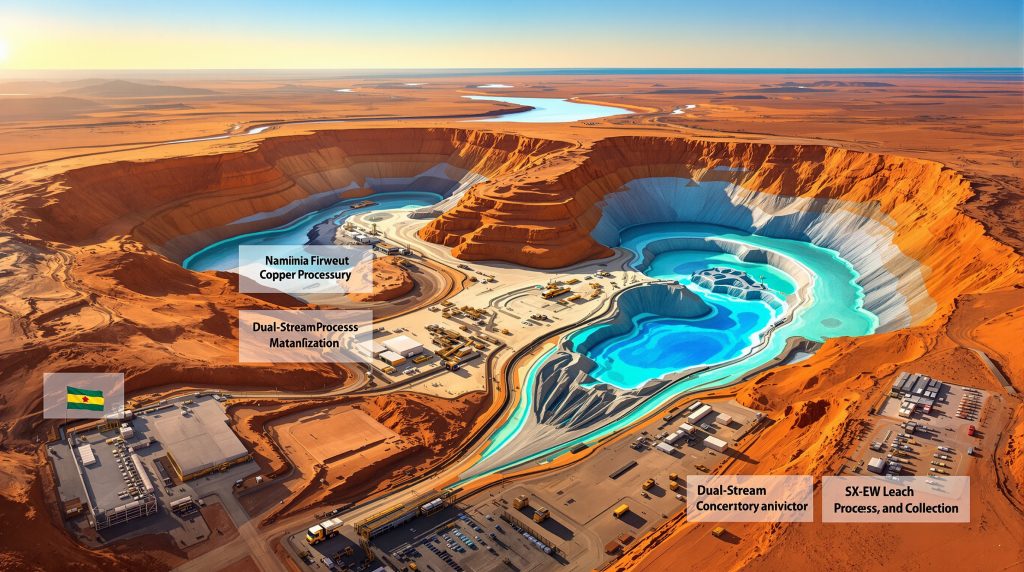What is the Haib Copper Project?
The Haib Copper Project stands as one of Namibia's most promising copper developments, strategically positioned in the southern ǁKaras Region near the South African border. This large-scale porphyry copper deposit encompasses approximately 37,000 hectares of mineral-rich terrain, with widespread mineralization identified throughout the property. Its development represents a critical opportunity for both Namibia's mining sector and the global copper market.
The project's location offers exceptional access to essential infrastructure, making it particularly attractive for development. Situated just 15 kilometers from a major highway and approximately 120 kilometers from existing rail connections, the site benefits from established transportation networks. This strategic positioning provides feasible access routes to Namibian ports, ensuring efficient export capabilities once production begins.
Water supply, often a critical concern for mining permitting basics in arid regions, is addressed through the project's proximity to the Orange River, which forms the border between Namibia and South Africa in this region. This natural water source represents a significant advantage for processing operations that typically require substantial water resources.
Furthermore, Namibia's reputation as a mining-friendly jurisdiction with established regulatory frameworks adds another layer of appeal to the project. The country's mining sector contributed approximately 12% to its GDP in 2023, according to the Namibia Statistics Agency, highlighting the industry's importance to the national economy.
Project Location and Infrastructure Advantages
The project's strategic position offers multiple infrastructural benefits that enhance its development potential:
- Located approximately 15 km from a major highway, enabling efficient transportation
- Positioned just 120 km from existing rail connections for product export
- Established access routes to Namibian ports for international shipping
- Proximity to the Orange River for potential water supply needs
- Situated within Namibia's stable mining regulatory environment
- Access to the country's existing mining service providers and expertise
How Large is the Haib Copper Resource?
The Haib deposit represents one of Africa's largest undeveloped copper resources, with extensive exploration revealing its substantial scale and economic potential. The deposit features consistent mineralization across a large area, with copper grades ranging from 0.3% to 0.5% in higher-grade zones.
Resource Estimation and Grade Profile
The comprehensive resource estimate demonstrates the significant scale of the Haib deposit:
| Resource Category | Tonnage (Mt) | Copper Grade (%) | Contained Copper (Mt) |
|---|---|---|---|
| Measured & Indicated | 456.9 | 0.31 | 1.42 |
| Inferred | 342.4 | 0.29 | 0.99 |
| Total Resource | 799.3 | 0.30 | 2.41 |
This substantial resource base positions Haib among the more significant undeveloped copper projects globally. The deposit's characteristics include:
- Widespread mineralization extending across the property
- Consistent grade distribution throughout the deposit
- Molybdenum credits enhancing the overall project economics
- Vertical continuity of mineralization extending beyond 800 meters depth
- Potential for resource expansion through ongoing gold & copper exploration programs
The molybdenum content, while not fully quantified in public disclosures, represents an important potential by-product credit that could significantly enhance the project's overall economics. Ongoing exploration work through early 2026 aims to better define these values.
What Makes Haib's Geology Unique?
Rare Paleoproterozoic Porphyry System
The Haib deposit stands out geologically as a rare Paleoproterozoic porphyry copper system in southern Africa, distinctly different from most African copper deposits which typically occur as sediment-hosted systems (such as those in the Central African Copperbelt). This geological distinction gives Haib unique characteristics worth noting:
- Formation approximately 1.8 billion years ago during the Paleoproterozoic era
- Multiple phases of intrusive activity creating extensive mineralization zones
- Dominant chalcopyrite mineralization with minor bornite and chalcocite
- Preservation of typical porphyry features despite multiple structural events
- Extensive alteration zones characteristic of productive porphyry systems
The deposit's age makes it particularly interesting from a geological perspective, as most actively mined porphyry copper deposits worldwide are significantly younger, typically formed during the Cenozoic or Mesozoic eras. Haib represents an ancient, yet well-preserved, porphyry system that has maintained its economic potential despite its age.
Mineralization Distribution and Patterns
The copper mineralization at Haib displays patterns typical of well-developed porphyry systems but with characteristics unique to its geological setting:
- Widespread disseminated mineralization ideal for bulk mining methods
- Higher-grade zones associated with intense fracturing and veining
- Vertical continuity of mineralization extending to depths exceeding 800 meters
- Potential for satellite deposits within the broader property package
- Stockwork veining and fracture-controlled mineralization
This mineralization style lends itself particularly well to bulk mining methods, with higher-grade zones providing opportunities for targeted early production phases. The vertical continuity of mineralization suggests potential for a deep mining operation with a long productive life.
What Production Model is Planned for Haib?
Dual-Stream Processing Strategy
The 2025 Preliminary Economic Assessment outlines an innovative dual-stream processing approach designed to maximize copper recovery across different ore types. This strategy represents a technically advanced solution to efficiently process the varying grades and types of ore present at the Haib Copper Project in Namibia:
- Conventional 8 million tonnes per annum (Mtpa) concentrator targeting higher-grade sulphide ore
- 17 Mtpa heap-leach hydrometallurgical plant processing lower-grade material
- Combined processing capacity of approximately 25 Mtpa
- Production of both copper concentrate and cathode copper
- Potential for molybdenum recovery as a valuable by-product
This dual-processing approach allows for optimization of different ore types, with higher-grade material directed to the conventional flotation circuit and lower-grade material processed through more cost-effective heap leaching. The combined approach maximizes resource utilization while maintaining economic viability.
Mining and Processing Technologies
The operation will employ modern technologies to ensure efficient extraction and processing:
- Conventional open-pit mining with a remarkably low strip ratio of 0.56:1
- Advanced ore sorting technologies to enhance feed grades to both processing circuits
- Flotation recovery rates up to 87% for higher-grade material, confirmed by metallurgical testing
- Heap leach recovery rates around 65% for lower-grade ore
- Solvent extraction-electrowinning (SX-EW) for producing cathode copper from heap leach solutions
The low strip ratio of 0.56:1 represents a significant economic advantage, as it means only 0.56 tonnes of waste material needs to be removed for each tonne of ore mined. This ratio is considerably lower than many comparable open-pit operations, which often have strip ratios of 2:1 or higher.
Metallurgical testing by respected firms including Maelgwyn Mineral Services, Mintek, and Ceibo has validated these recovery rates, confirming the project's processing approach. These tests have demonstrated that the Haib ore is amenable to both flotation and heap leaching, providing flexibility in processing options.
What are Haib's Production Targets and Economics?
Annual Production Profile
The project is designed to deliver consistent long-term copper production throughout its operational life:
- Annual production ranging from 35,000 to 40,000 tonnes of copper
- Average annual production of 38,000 tonnes in combined concentrate and cathode
- First decade production expected to peak at approximately 92,000 tonnes annually
- 23-year mine life based on current resource estimates
- Potential for mine life extension through resource expansion and exploration success
The significantly higher production rate in the first decade (92,000 tonnes annually) compared to the life-of-mine average (38,000 tonnes) suggests a front-loaded production schedule that prioritizes higher-grade material early in the mine life, maximizing early returns on investment.
Economic Highlights from the 2025 PEA
The October 2025 Preliminary Economic Assessment presents robust economics for the Haib project:
| Economic Parameter | Value |
|---|---|
| Post-tax NPV (8%) | US$1.35 billion (N$25.2 billion) |
| Internal Rate of Return (IRR) | 35% |
| Payback Period | 3.5 years |
| Initial Capital Cost | US$340 million (N$6.4 billion) |
| Sustaining Capital | US$100 million (life of mine) |
| Operating Cost | US$1.28 per pound of copper |
| Pre-production Costs | US$15-20 million |
These strong economic indicators position Haib competitively within the global copper development pipeline. The 35% IRR is particularly notable, as projects with IRRs exceeding 30% are generally considered highly attractive to investors. The relatively modest initial capital requirement of US$340 million also makes the project more accessible for financing compared to many large-scale copper developments.
The project's operating cost of US$1.28 per pound places Haib within the lower half of the global cost curve for porphyry copper operations. This competitive position is driven by several factors:
- High throughput capabilities maximizing economies of scale
- Exceptionally favorable strip ratio minimizing mining costs
- Namibia's well-established mining infrastructure reducing development complexity
- Efficient dual-stream processing approach optimizing recovery from varying ore types
How Will the Haib Project Be Developed?
Development Timeline and Milestones
According to information reported by African Mining Market in October 2025, the project development is proceeding through several defined phases:
- Ongoing infill and expansion drilling through early 2026
- Resource updates and detailed mine planning in first half of 2026
- Definitive feasibility studies, permitting, and financing to follow
- Construction and commissioning expected to take 24-30 months from final investment decision
- Heap-leach circuit and SX-EW plant targeted for first production in Year 3 from FID
- Concentrator commissioning approximately six months after heap-leach startup
- Full production capacity expected by Year 5 (potentially 2028)
The phased approach to development, with the heap-leach operation coming online before the concentrator, allows for earlier revenue generation while the more complex flotation circuit is completed. This strategy helps de-risk the project by establishing cash flow before the full capital expenditure is completed.
Critical Infrastructure Requirements
The project will require significant infrastructure development to support its operations:
- Power requirements estimated at 150 MW
- Water demand projected at 20 million cubic meters annually
- Road upgrades and potential rail connections for product transportation
- Accommodation facilities for the operational workforce
- Tailings storage and waste rock facilities designed to modern standards
Securing reliable power and water supply represents one of the key development challenges for the project. The substantial power requirement of 150 MW will likely require coordination with Namibia's national utility to ensure adequate supply, possibly including dedicated transmission infrastructure.
The water demand of 20 million cubic meters annually highlights the importance of the project's proximity to the Orange River as a potential water source. Developing sustainable water management solutions will be critical to the project's long-term success, including potential water recycling and conservation measures.
What Technical Validation Supports the Project?
Metallurgical Testing and Process Design
Extensive metallurgical test work has been conducted by leading specialists to validate the processing approach:
- Test programs completed by Maelgwyn Mineral Services, a recognized international metallurgical testing firm
- Additional validation by Mintek, South Africa's national mineral research organization established in 1934
- Confirmation of flotation recoveries up to 87% for sulphide ore
- Heap leach recovery validation at approximately 65% for oxide and transitional material
- Process flowsheet optimization for variable ore types encountered across the deposit
This comprehensive testing program provides confidence in the projected recovery rates and process design. The involvement of established metallurgical laboratories with extensive experience in similar ore types adds credibility to the technical aspects of the project.
Engineering and Design Considerations
The project design incorporates modern approaches to maximize efficiency and sustainability:
- State-of-the-art processing technologies to optimize recovery rates
- Energy efficiency measures integrated throughout the operation
- Water conservation and recycling systems to minimize consumption
- Tailings management designed to current international standards
- Potential for renewable energy integration to reduce carbon footprint and operating costs
The engineering design also considers the arid environment of southern Namibia, with particular attention to water conservation and management. These considerations are increasingly important for mining projects globally as environmental standards continue to evolve.
What Environmental and Social Considerations Apply?
Environmental Management Framework
The project development includes comprehensive environmental planning to address potential impacts:
- Baseline environmental studies already underway to document pre-mining conditions
- Water management strategies to minimize consumption in this arid region
- Dust and noise mitigation measures to reduce operational impacts
- Progressive rehabilitation planning throughout the mine life
- Biodiversity conservation initiatives to protect local ecosystems
Water management represents a particularly important aspect of environmental planning for the Haib project, given its location in the arid ǁKaras Region. Developing sustainable water sourcing and recycling systems will be critical to minimizing environmental impact while ensuring operational viability.
Community Engagement and Benefits
The development strategy emphasizes creating lasting benefits for local communities:
- Local employment and skills development opportunities throughout project life
- Community infrastructure improvement programs based on local priorities
- Transparent stakeholder engagement processes to build trust
- Economic diversification support for local communities
- Long-term sustainable development initiatives extending beyond mining
These initiatives align with modern expectations for mining projects to deliver broader socioeconomic benefits beyond direct employment. Creating lasting positive impacts for local communities has become increasingly important for securing and maintaining social license to operate for mining projects globally.
How Does Haib Fit into the Global Copper Market?
Strategic Importance for Namibia
The Haib project represents a significant opportunity for Namibia's economic development:
- Potential to become one of the country's largest mining operations
- Substantial export revenue generation estimated at US$340-380 million annually
- Skills development and technology transfer benefits strengthening the local workforce
- Infrastructure improvements with broader economic benefits beyond mining
- Support for Namibia's green industrialization goals through copper production
With average annual production of 38,000 tonnes of copper and current copper price insights around US$9,000-10,000 per tonne, the project could generate US$340-380 million in annual revenue. This represents a significant contribution to Namibia's export earnings and economic diversification efforts.
Global Copper Supply Context
The project's development coincides with critical dynamics in global copper production:
- Growing supply deficits projected as demand outpaces new production
- Increasing demand driven by energy transition and electrification trends
- Limited development pipeline of large-scale copper projects globally
- Rising importance of politically stable mining jurisdictions for supply security
- Growing premium for responsibly produced copper meeting ESG standards
The timing of Haib's potential development around 2028 could coincide with projected copper market deficits, as global demand for copper in renewable energy technologies, electric vehicles, and grid infrastructure continues to grow. This market context enhances the strategic importance of bringing new copper projects like Haib into production.
What Challenges and Opportunities Lie Ahead?
Development Challenges
Key challenges for the project include several areas that will require focused attention:
- Securing necessary capital funding in competitive mining investment markets
- Managing water supply sustainably in an arid region
- Ensuring adequate power infrastructure development
- Optimizing processing for the relatively low-grade ore
- Navigating evolving regulatory requirements for mining projects
Water management represents perhaps the most critical physical challenge, given the project's substantial water requirements in an arid environment. Developing sustainable solutions for water supply, possibly including advanced recycling technologies, will be essential for long-term success.
Future Expansion Opportunities
The project offers several avenues for potential enhancement beyond the base case presented in the PEA:
- Resource expansion through continued exploration of the extensive property
- Processing technology improvements to enhance recoveries over time
- Production scale increases as regional infrastructure develops
- By-product recovery optimization, particularly for molybdenum
- Renewable energy integration to reduce carbon footprint and energy costs
The potential for resource expansion is particularly significant, as the current 23-year mine life is based on resources delineated to date, with further exploration potential across the property. Successful exploration could extend the mine life substantially or support higher production rates.
Frequently Asked Questions About the Haib Copper Project
Who owns the Haib Copper Project?
The Haib Copper Project is wholly owned by Koryx Copper Inc., a Canadian mining development company that acquired the project and has been actively advancing it since 2024. The company is focused on bringing the project through final feasibility studies and into production.
When will the Haib Copper Project start producing?
Based on the current development timeline, first copper production from the heap-leach circuit and SX-EW plant is expected approximately three years after the final investment decision, with the concentrator coming online about six months later. Full production capacity should be reached by Year 5 of the development schedule, potentially around 2028.
How does Haib compare to other copper projects globally?
The Haib project ranks as a medium to large-scale copper development with competitive economics. While its grade is lower than some premium projects, its advantages include a very low strip ratio, excellent infrastructure access, and a politically stable jurisdiction. Its operating costs position it in the lower half of the global cost curve for porphyry copper operations.
What impact will Haib have on Namibia's economy?
The project represents a significant economic opportunity for Namibia mining update, with potential to generate hundreds of millions of dollars in export revenue annually, create substantial direct and indirect employment, and contribute to infrastructure development. The project aligns with Namibia's economic diversification and industrialization strategies.
Want to Stay Ahead of Major Mineral Discoveries?
Discovery Alert's proprietary Discovery IQ model provides instant notifications on significant ASX mineral discoveries, turning complex data into actionable investment insights. Explore why historic discoveries like copper projects can generate substantial returns by visiting our dedicated discoveries page and begin your 30-day free trial today.




